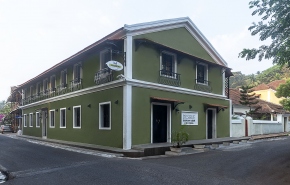- Axis Mutual Fund launches Axis Global Innovation Fund of Fund
- IHCL EXPANDS amã STAYS & TRAILS PORTFOLIO IN GOA
- Ending Period Taboo
- Scheme Snafu
- Equal Future
- Transcending Stereotypes
- Reboot for 2021- Refreshed & renewed with Jiva spa @ Taj, Goa
- Cottonfab 2021 at Kala Akademy
- Lockdown Dairy: Fests & Zatras remembered
- Aby Jose
Putting the best foot forward
We can tackle the complications of foot and ankle injury from diabetes with a systematic approach
India is the diabetes capital of the world. If we extrapolate this information to the complications of diabetes, then one can conclude that diabetic foot ulcer is at the top of the list.
Diabetes destroys our body slowly but surely despite good control of sugar. The longer you have it, the more the chances of complications.
Loss of sensation in the foot is caused by damage to the nerves’ myelin sheath which results in loss of balance and also inability to feel pain. This is a dangerous situation that exposes our feet to new deformities, loss of sweating leading to drying of skin and loss of pain sensation.
This triad creates abnormal pressure points on the sole, sides and toes. Shoe bites, corns, infected nails and cracked heel pads are early warning signs of impending foot ulcer.
Due to loss of pain sensation this early, ulcers go undetected and can turn into chronic infected ulcers reaching the underlying bone, which in 30-40 per cent of cases end up in below-knee amputation. Poor blood supply due to associated atherosclerosis (narrow blood vessels) also compromises the healing response and may cause local gangrene.
To add insult to injury, the present attitude and methods of treatment are outdated with no science to support them. Lack of proper understanding of foot biomechanics and the disease process mean the foot ulcer is treated by the least experienced doctor due to a defeatist attitude, presuming that nothing good can happen and will eventually lead to amputation.
So what can we do to prevent amputation? Prevent formation of the ulcer.
Plan of Action
l Tight control of sugar by appropriate medication (tablets and/or insulin).
l Education on diabetes control, nutrition and skin care for the foot to prevent drying, look for early lesions, like corns, cracked skin, nail infections, etc.
l Use of special footwear, total contact cast to redistribute the forces on the sole and off-load the pressure points. (Offloading Orthotics).
l Early surgery to clean the ulcer
and start antibiotics to prevent and control infection.
l Treat associated diseases like hypertension, high lipids, obesity, uric acid, etc.
l Improve blood flow by drugs or by angioplasty on the blocked or narrowed vessels.
l Team approach which includes the patient, diabetes wound care nurse, surgeon, orthopaedic foot and ankle specialist, physician, vascular surgeon, plastic surgeon, orthotist, prosthetist, dietician, social and psychology counsellor.
We need grass root-level sensitisation of patients, doctors and the public about the perils of the problem and prevention strategies. We also need to provide a safe environment for patients including access to get educated, receive comprehensive treatment and have regular follow ups to prevent recurrence or progression of complications.
Rotary Foundation can have a long-term project to win over this deadly disease so that we save limbs and lives; and give our country a productive and self-sustaining citizen who is not a burden on the healthcare budget.
Plan:
1. Improve awareness by advertising
2. Educate public by seminars through print, digital media, radio and TV
3. Distribute educational pamphlets
4. Collaborate with healthcare facilities in government and private sectors to improve attitude, infrastructure and trained manpower












